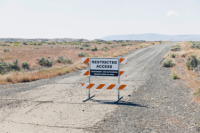We will tell the story of Hanford from different perspectives using an environmental justice lens.
Read or Listen to our Strategic Plan Now:
Our Goals
- Hold the U.S. government accountable for a Hanford cleanup that protects the Columbia River, people who are impacted by Hanford pollution, and the rights of Tribal Nations
- Work in solidarity with Yakama Nation, including supporting an outreach position at the Tribe, and increase solidarity work with Confederated Tribes of Umatilla Indian Reservation, Nez Perce, and Warm Springs
- Increase outreach and engagement of Latina/o/x communities impacted by Hanford’s nuclear legacy
The Problem
The Columbia River runs along the Hanford Nuclear Site, home to some of the most dangerous pollution on Earth. A legacy of World War II and the Cold War, the federal government selected Hanford as a top-secret site for the Manhattan Project, which called for enriching plutonium for nuclear weapons. The 586-square-mile Hanford Site rests on the ceded lands of multiple Tribal Nations. Today, Tribes and Indigenous people are leading the effort to hold the U.S. government accountable for cleanup. Radioactive and toxic pollution from Hanford threatens people’s health, salmon, and water quality. The stark reality: contamination from Hanford still reaches the Columbia River. Without effective cleanup, more pollution threatens to escape into the environment in the coming decades. For example, at Hanford, cancer- causing strontium-90 levels in groundwater near the Columbia are 2000 times above the drinking water standard. Radiation levels in soils are lethally dangerous just a few hundred yards from the Columbia. Cleanup along the Columbia remains far from complete.

Our Plan
Work in solidarity with Tribal Nations to stop proposals to build new nuclear reactors at Hanford.
Advocate for strong River Corridor cleanup plans and challenge plans that fail to protect people’s health and the river. Speak up for thorough cleanup and transparency at Hanford, including identification and remediation of aging, high-hazard facilities on the site that are at risk of failure.
Convince the U.S. Department of Energy to abandon its proposal to reclassify high-level waste at Hanford and hold the U.S. Department of Energy accountable to the Tri-Party Agreement.
Implement communications and outreach strategies that are accessible, including Spanish translation, and provide compelling visuals that tell the story of the people and places impacted by Hanford and cleanup decisions.
Press agencies to hold meetings and hearings outside of the Tri-Cities to engage a broader cross-section of the Pacific Northwest in Hanford cleanup.
Build and maintain relationships with Latina/o/x communities, with a particular focus on the Yakama Nation Reservation, Yakima, and Tri-Cities, to improve outreach and engagement on Hanford and work in solidarity on select social justice issues.
Tell the story of Hanford from different perspectives using an environmental justice lens. This includes engaging people to speak about the risks of Hanford’s pollution to people who live, fish, and otherwise use the Columbia near Hanford.

